Classical element


| Classical elements |
|---|
Theclassical elementstypically refer toearth,water,air,fire,and (later)aetherwhich were proposed to explain the nature and complexity of allmatterin terms of simplersubstances.[1][2]Ancient cultures inGreece,Angola,Tibet,India,andMalihad similar lists which sometimes referred, in local languages, to "air" as "wind", and to "aether" as "space".
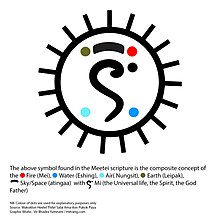
These different cultures and even individual philosophers had widely varying explanations concerning their attributes and how they related to observable phenomena as well ascosmology.Sometimes these theories overlapped withmythologyand werepersonified in deities.Some of these interpretations includedatomism(the idea of very small, indivisible portions of matter), but other interpretations considered the elements to be divisible into infinitely small pieces without changing their nature.
While the classification of the material world in ancientIndia,Hellenistic Egypt,andancient Greeceinto air, earth, fire, and water was more philosophical, during theMiddle Agesmedievalscientistsused practical, experimental observation to classify materials.[3]InEurope,the ancient Greek concept, devised byEmpedocles,evolved into the systematic classifications ofAristotleandHippocrates.This evolved slightly into the medieval system, and eventually became the object of experimental verification in the 17th century, at the start of theScientific Revolution.[4]
Modern sciencedoes not support the classical elements to classify types of substances.Atomic theoryclassifies atoms into more than a hundredchemical elementssuch asoxygen,iron,andmercury,which may formchemical compoundsandmixtures.The modern categories roughly corresponding to the classical elements are thestates of matterproduced under different temperatures and pressures.Solid,liquid,gas,andplasmashare many attributes with the corresponding classical elements of earth, water, air, and fire, but these states describe the similar behavior of different types of atoms at similar energy levels, not the characteristic behavior of certain atoms or substances.
Hellenistic philosophy
[edit]
| Aristotelian elements and qualities |
 Empedoclean elements |
Theancient Greekconcept of four basic elements, these being earth (γῆgê), water (ὕδωρhýdōr), air (ἀήρaḗr), and fire (πῦρpŷr), dates frompre-Socratictimes and persisted throughout theMiddle Agesand into theEarly modern period,deeply influencingEuropeanthought and culture.[5]
Pre-Socratic elements
[edit]Water, air, or fire?
[edit]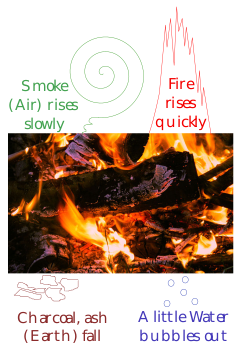
The classical elements were first proposed independently by several early Pre-Socratic philosophers.[6]Greek philosophers had debated which substance was thearche( "first principle" ), or primordial element from which everything else was made.Thales(c. 626/623– c. 548/545 BC) believed that water was this principle.Anaximander(c. 610– c. 546 BC) argued that the primordial substance was not any of the known substances, but could be transformed into them, and they into each other.[7][5]Anaximenes(c. 586– c. 526 BC) favored air, andHeraclitus(fl. c. 500 BC) championed fire.[8]
Fire, earth, air, and water
[edit]TheGreekphilosopherEmpedocles(c. 450 BC) was the first to propose the four classical elements as a set: fire, earth, air, and water.[9]He called them the four "roots" (ῥιζώματα,rhizōmata). Empedocles also proved (at least to his own satisfaction) that air was a separate substance by observing that a bucket inverted in water did not become filled with water, a pocket of air remaining trapped inside.[10]
Fire, earth, air, and water have become the most popular set of classical elements in modern interpretations. One such version was provided byRobert BoyleinThe Sceptical Chymist,which was published in 1661 in the form of a dialogue between five characters.Themistius,theAristotelianof the party, says:[11]
If You but consider a piece of green-Wood burning in a Chimney, You will readily discern in the disbanded parts of it the four Elements, of which we teach It and other mixt bodies to be compos’d. The fire discovers it self in the flame... the smoke by ascending to the top of the chimney, and there readily vanishing into air... manifests to what Element it belongs and gladly returnes. The water... boyling and hissing at the ends of the burning Wood betrayes it self... and the ashes by their weight, their firiness, and their dryness, put it past doubt that they belong to the Element of Earth.
Humorism (Hippocrates)
[edit]
According toGalen,these elements were used byHippocrates(c. 460– c. 370 BC) in describing thehuman bodywith an association with thefour humours:yellowbile(fire),black bile(earth),blood(air), andphlegm(water). Medical care was primarily about helping the patient stay in or return to their own personal natural balanced state.[12]
Plato
[edit]
Plato(428/423 – 348/347 BC) seems to have been the first to use the term "element (στοιχεῖον,stoicheîon) "in reference to air, fire, earth, and water.[13]The ancient Greek word for element,stoicheion(fromstoicheo,"to line up" ) meant "smallest division (of a sun-dial), a syllable", as the composing unit of an Alpha bet it could denote a letter and the smallest unit from which a word is formed.
Aristotle
[edit]
InOn the Heavens(350 BC), Aristotle defines "element" in general:[14][15]
An element, we take it, is a body into which other bodies may be analysed, present in them potentially or in actuality (which of these, is still disputable), and not itself divisible into bodies different in form. That, or something like it, is what all men in every case mean by element.[16]
— Aristotle, On the Heavens, Book III, Chapter III
In hisOn Generation and Corruption,[17][18]Aristotle related each of the four elements to two of the four sensible qualities:
- Fireis both hot and dry.
- Airis both hot and wet (for air is like vapor,ἀτμὶς).
- Wateris both cold and wet.
- Earthis both cold and dry.
A classic diagram has one squareinscribedin the other, with the corners of one being the classical elements, and the corners of the other being the properties. The opposite corner is the opposite of these properties, "hot – cold" and "dry – wet".
Aether
[edit]Aristotleadded a fifth element,aether(αἰθήρaither), as the quintessence, reasoning that whereas fire, earth, air, and water were earthly and corruptible, since no changes had been perceived in the heavenly regions, thestarscannot be made out of any of the four elements but must be made of a different, unchangeable, heavenly substance.[19]It had previously been believed by pre-Socratics such as Empedocles andAnaxagorasthat aether, the name applied to the material of heavenly bodies, was a form of fire. Aristotle himself did not use the termaetherfor the fifth element, and strongly criticised the pre-Socratics for associating the term with fire. He preferred a number of other terms indicating eternal movement, thus emphasising the evidence for his discovery of a new element.[20]These five elements have been associated since Plato'sTimaeuswith the fiveplatonic solids.
Neo-Platonism
[edit]TheNeoplatonicphilosopherProclusrejected Aristotle's theory relating the elements to the sensible qualities hot, cold, wet, and dry. He maintained that each of the elements has three properties. Fire is sharp (ὀξυτητα), subtle (λεπτομερειαν), and mobile (εὐκινησιαν) while its opposite, earth, is blunt (αμβλυτητα), dense (παχυμερειαν), and immobile (ακινησιαν[21]); they are joined by the intermediate elements, air and water, in the following fashion:[22]
| Fire | Sharp | Subtle | Mobile |
|---|---|---|---|
| Air | Blunt | Subtle | Mobile |
| Water | Blunt | Dense | Mobile |
| Earth | Blunt | Dense | Immobile |
Hermeticism
[edit]A text written in Egypt inHellenisticorRomantimes called theKore Kosmou( "Virgin of the World" ) ascribed toHermes Trismegistus(associated with the Egyptian godThoth), names the four elements fire, water, air, and earth. As described in this book:
And Isis answer made: Of living things, my son, some are made friends withfire,and some withwater,some withair,and some withearth,and some with two or three of these, and some with all. And, on the contrary, again some are made enemies of fire, and some of water, some of earth, and some of air, and some of two of them, and some of three, and some of all. For instance, son, the locust and all flies flee fire; the eagle and the hawk and all high-flying birds flee water; fish, air and earth; the snake avoids the open air. Whereas snakes and all creeping things love earth; all swimming things love water; winged things, air, of which they are the citizens; while those that fly still higher love the fire and have the habitat near it. Not that some of the animals as well do not love fire; for instance salamanders, for they even have their homes in it. It is because one or another of the elements doth form their bodies' outer envelope. Eachsoul,accordingly, while it is in its body is weighted and constricted by these four.[23]
Ancient Indian philosophy
[edit]Hinduism
[edit]
The system of five elements are found inVedas,especiallyAyurveda,thepancha mahabhuta,or "five great elements", ofHinduismare:
- bhūmiorpṛthvī(earth),[24]
- āpasorjala(water),
- agníortejas(fire),
- vāyu,vyāna,orvāta(airorwind)
- ākāśa,vyom,orśūnya(space or zero) or (aetherorvoid).[25]
They further suggest that all of creation, including the human body, is made of these five essential elements and that upon death, the human body dissolves into these five elements of nature, thereby balancing the cycle of nature.[26]
The five elements are associated with the five senses, and act as the gross medium for the experience of sensations. The basest element, earth, created using all the other elements, can be perceived by all five senses — (i) hearing, (ii) touch, (iii) sight, (iv) taste, and (v) smell. The next higher element, water, has no odor but can be heard, felt, seen and tasted. Next comes fire, which can be heard, felt and seen. Air can be heard and felt. "Akasha" (aether) is beyond the senses of smell, taste, sight, and touch; it being accessible to the sense of hearing alone.[27][28][29]
Buddhism
[edit]
Buddhism has had a variety of thought about the five elements and their existence and relevance, some of which continue to this day.
In thePali literature,themahabhuta( "great elements" ) orcatudhatu( "four elements" ) are earth, water, fire and air. Inearly Buddhism,the four elements are a basis for understanding suffering and for liberating oneself from suffering. The earliestBuddhist textsexplain that the four primary material elements are solidity, fluidity, temperature, and mobility, characterized as earth, water, fire, and air, respectively.[30]
TheBuddha's teaching regarding the four elements is to be understood as the base of all observation of real sensations rather than as a philosophy. The four properties are cohesion (water), solidity or inertia (earth), expansion or vibration (air) and heat or energy content (fire). He promulgated a categorization of mind and matter as composed of eight types of "kalapas"of which the four elements are primary and a secondary group of four are colour, smell, taste, and nutriment which are derivative from the four primaries.[31][a][32]
Thanissaro Bhikkhu(1997) renders an extract ofShakyamuni Buddha's from Pali into English thus:
Just as a skilled butcher or his apprentice, having killed a cow, would sit at a crossroads cutting it up into pieces, the monk contemplates this very body — however it stands, however it is disposed — in terms of properties: 'In this body there is the earth property, the liquid property, the fire property, & the wind property.'[33]
Tibetan Buddhistmedical literature speaks of thepañca mahābhūta(five elements) or "elemental properties":[34]earth, water, fire, wind, and space.[34]The concept was extensively used intraditional Tibetan medicine.[35][36][34]Tibetan Buddhisttheology,tantratraditions, and "astrological texts" also spoke of them making up the "environment, [human] bodies," and at the smallest or "subtlest" level of existence, parts of thought and the mind.[34]Also at the subtlest level of existence, the elements exist as "pure natures represented by the five female buddhas", Ākāśadhātviśvarī, Buddhalocanā, Mamakī, Pāṇḍarāvasinī, and Samayatārā, and these pure natures "manifest as the physical properties of earth (solidity), water (fluidity), fire (heat and light), wind (movement and energy), and" the expanse of space.[34]These natures exist as all "qualities" that are in the physical world and take forms in it.[34]
Ancient African philosophy
[edit]Angola
[edit]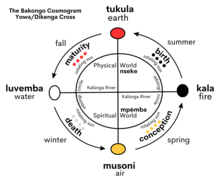
In traditionalBakongo religion,the five elements are incorporated into theKongo cosmogram.This sacred symbol also depicts the physical world (Nseke), the spiritual world of the ancestors (Mpémba), theKalûnga linethat runs between the two worlds, the circular void that originally formed the two worlds (mbûngi), andthe path of the sun.Each element correlates to a period in the life cycle, which the Bakongo people also equate to the fourcardinal directions.According to their cosmology, all living things go through this cycle.[37]
- Aetherrepresentsmbûngi,the circular void that begot the universe.
- Air(South) representsmusoni,the period of conception that takes place during spring.
- Fire(East) representkala,the period of birth that takes place during summer.
- Earth(North) representstukula,the period of maturity that takes place during fall.
- Water(West) representsluvemba,the period of death that takes place during winter
Mali
[edit]In traditionalBambaraspirituality, theSupreme Godcreated four additional essences of himself during creation. Together, these five essences of the deity correlate with the five classical elements.[38][39]
- Koni is the thought and void (aether).
- Bemba (also called Pemba) is the god of the sky andair.
- Nyale (also called Koroni Koundyé) is the goddess offire.
- Faro is the androgynous god ofwater.
- Ndomadyiri is the god and master of theearth.
Post-classical history
[edit]Alchemy
[edit]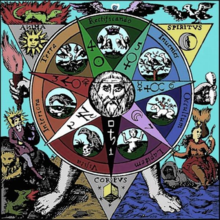
The elemental system used in medievalalchemywas developed primarily by the anonymous authors of the Arabic works attributed to PseudoApollonius of Tyana.[40]This system consisted of the four classical elements of air, earth, fire, and water, in addition to a new theory called thesulphur-mercury theory of metals,which was based on two elements:sulphur,characterizing the principle of combustibility, "the stone which burns"; andmercury,characterizing the principle of metallic properties. They were seen by early alchemists as idealized expressions of irreducible components of theuniverse[41]and are of larger consideration within philosophical alchemy.
The three metallic principles—sulphur to flammability or combustion, mercury to volatility and stability, andsaltto solidity—became thetria primaof the Swiss alchemistParacelsus.He reasoned that Aristotle's four element theory appeared in bodies as three principles. Paracelsus saw these principles as fundamental and justified them by recourse to the description of how wood burns in fire. Mercury included the cohesive principle, so that when it left in smoke the wood fell apart. Smoke described the volatility (the mercurial principle), the heat-giving flames described flammability (sulphur), and the remnant ash described solidity (salt).[42]
Japan
[edit]
Japanesetraditions use a set of elements called theNăm đại(godai,literally "five great" ). These five areearth,water,fire,wind/air, andvoid.These came from IndianVastu shastraphilosophy and Buddhist beliefs; in addition, theclassical Chinese elements(Ngũ hành,wu xing) are also prominent in Japanese culture, especially to the influential Neo-Confucianists during the medievalEdo period.[43]
- Earthrepresented rocks and stability.
- Waterrepresented fluidity and adaptability.
- Firerepresented life and energy.
- Windrepresented movement and expansion.
- VoidorSky/Heavenrepresented spirit and creative energy.
Medieval Aristotelian philosophy
[edit]TheIslamic philosophersal-Kindi,AvicennaandFakhr al-Din al-RazifollowedAristotlein connecting the four elements with the four natures heat and cold (the active force), and dryness and moisture (the recipients).[44]
Medicine Wheel
[edit]The medicine wheel symbol is a modern invention attributed toNative Americanpeoples dating to approximately 1972, with the following descriptions and associations being a later addition. The associations with the classical elements are not grounded in traditional Indigenous teachings and the symbol has not been adopted by all Indigenous American nations.[45][46][47][48][49]
- Earth(South) represents the youth cycle,summer,the Indigenous race, andcedarmedicine.
- Fire(East) represents the birth cycle,spring,the Asian race, andtobaccomedicine.
- Wind/Air(North) represents the elder cycle,winter,the European race, andsweetgrassmedicine.
- Water(West) represents the adulthood cycle,autumn,the African race, andsagemedicine.
Modern history
[edit]
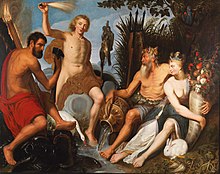
Chemical element
[edit]TheAristotelian traditionand medievalalchemyeventually gave rise to modernchemistry,scientific theories and new taxonomies. By the time ofAntoine Lavoisier,for example, alist of elementswould no longer refer to classical elements.[50]Some modern scientists see a parallel between the classical elements and the fourstates of matter:solid,liquid,gasand weakly ionizedplasma.[51]
Modern science recognizes classes ofelementary particleswhich have no substructure (or rather, particles that are not made of other particles) andcomposite particleshaving substructure (particles made of other particles).
Western astrology
[edit]
Westernastrologyuses the fourclassical elementsin connection withastrological chartsandhoroscopes.The twelvesignsof thezodiacare divided into the four elements:Fire signsare Aries, Leo and Sagittarius,Earth signsare Taurus, Virgo and Capricorn,Air signsare Gemini, Libra and Aquarius, andWater signsare Cancer, Scorpio, and Pisces.[52]
Criticism
[edit]The Dutch historian of scienceEduard Jan Dijksterhuiswrites that the theory of the classical elements "was bound to exercise a really harmful influence. As is now clear, Aristotle, by adopting this theory as the basis of his interpretation of nature and by never losing faith in it, took a course which promised few opportunities and many dangers for science."[53]Bertrand Russellsays that Aristotle's thinking became imbued with almost biblical authority in later centuries. So much so that "Ever since the beginning of the seventeenth century, almost every serious intellectual advance has had to begin with an attack on some Aristotelian doctrine".[54]
See also
[edit]- Arche– Basic proposition or assumption
- Elemental– Mythic entity personifying one of the classical elements
- Jabir ibn Hayyan § The sulfur-mercury theory of metals– Early Islamic alchemy
- Periodic table– Tabular arrangement of the chemical elements ordered by atomic number
- Phlogiston theory– Superseded theory of combustion
- Prima materia– First or prime matter
- Qi– Vital force in traditional Chinese philosophy
- Wu xing (Chinese philosophy)– Chinese five elements
Notes
[edit]- ^Thera (1956),pp. 318–320: "the atomic theory prevailed in India in the time of the Buddha. Paramàõu was the ancient term for the modern atom. According to the ancient belief one rathareõu consists of 16 tajjàris, one tajjàri, 16 aõus; one aõu, 16 paramàõus. The minute particles of dust seen dancing in the sunbeam are called rathareõus. One para-màõu is, therefore, 4096th part of a rathareõu. This para-màõu was considered indivisible. With His supernormal knowledge the Buddha analysed this so-called paramàõu and declared that it consists of paramatthas—ultimate entities which cannot further be subdivided." "ñhavi in earth, àpo in water, tejo in fire, and vàyo in air. They are also called Mahàbhåtas or Great Essentials because they are invariably found in all material substances ranging from the infinitesimally small cell to the most massive object. Dependent on them are the four subsidiary material qualities of colour (vaõõa)., smell (gandha), taste (rasa), and nutritive essence (ojà). These eight coexisting forces and qualities constitute one material group called 'Suddhaññhaka Rupa kalàpa—pure-octad material group'."
References
[edit]- ^Boyd, T.J.M.; Sanderson, J.J. (2003).The Physics of Plasmas.Cambridge University Press. p.1.ISBN9780521459129.LCCN2002024654.
- ^Ball, P. (2004).The Elements: A Very Short Introduction.Very Short Introductions. OUP Oxford. p. 33.ISBN9780191578250.
- ^Al-Khalili, Jim(2009).Science and Islam.BBC.
- ^"Chemistry in the Ancient World".Nature.140(3554): 1006. 1 December 1937.Bibcode:1937Natur.140Q1006..doi:10.1038/1401006a0.ISSN1476-4687.S2CID44886438.
- ^abCurd (2020).
- ^Ross (2020).
- ^Russell (1991),p. 46.
- ^Russell (1991),p. 61.
- ^Russell (1991),pp. 62, 75.
- ^Russell (1991),p. 72.
- ^Boyle, Robert (1661).The Sceptical Chymist: or Chymico-Physical Doubts & Paradoxes, Touching the Spagyrist's Principles Commonly call'd Hypostatical; As they are wont to be Propos'd and Defended by the Generality of Alchymists. Whereunto is præmis'd Part of another Discourse relating to the same Subject.Printed by J. Cadwell for J. Crooke. pp. 21–22.
- ^Lindemann, Mary (2010).Medicine and Society in early Modern Europe.Cambridge University Press. p. 19.ISBN978-0-521-73256-7.
- ^Plato,Timaeus,48b
- ^Weisberg, M.; Needham, P.; Hendry, R. (2019),"Philosophy of Chemistry",in Zalta, E. N. (ed.),The Stanford Encyclopedia of Philosophy(Spring 2019 ed.), Metaphysics Research Lab, Stanford University
- ^Aristotle (1922) [350 BCE].On the Heavens.Translated by Stocks, J. L. pp. 3.3, 302a17–19.
- ^Aristotle,On the Heavens,translated by Stocks, J.L., III.3.302a17–19
- ^Aristotle.(in Greek) – viaWikisource.
τὸ μὲν γὰρ πῦρ θερμὸν καὶ ξηρόν, ὁ δ' ἀὴρ θερμὸν καὶ ὑγρόν (οἷον ἀτμὶς γὰρ ὁ ἀήρ), τὸ δ' ὕδωρ ψυχρὸν καὶ ὑγρόν, ἡ δὲ γῆ ψυχρὸν καὶ ξηρόν
- ^Lloyd (1968),pp. 166–169.
- ^Lloyd (1968),pp.133–139.
- ^Chung-Hwan, Chen(1971). "Aristotle's analysis of change and Plato's theory of Transcendent Ideas". In Anton, John P.; Preus, Anthony (eds.).Ancient Greek Philosophy.Vol. 2. SUNY Press. pp. 406–407.ISBN0873956230..
- ^Siorvanes, Lucas (1986).Proclus on the Elements and the Celestial Bodies: Physical Thought in Late Neoplatonism(PDF)(Thesis). p. 168.
- ^Proclus,Commentary on Plato'sTimaeus,3.38.1–3.39.28
- ^Mead, G. R. S.(1906).Thrice-Greatest Hermes.Vol. 3. London & Benares: The Theosophical Publishing Society. pp. 133–134.OCLC76743923.
- ^Gopal, Madan (1990). K.S. Gautam (ed.).India through the ages.Publication Division, Ministry of Information and Broadcasting, Government of India. p.78.
- ^Ranade, Subhash (December 2001).Natural Healing Through Ayurveda.Motilal Banarsidass Publisher. p. 32.ISBN9788120812437.
- ^Jagannathan, Maithily.South Indian Hindu Festivals and Traditions.Abhinav Publications. pp. 60–62.
- ^Meyer-Dinkgräfe, Daniel (2005).Theatre and Consciousness: Explanatory Scope and Future Potential.Intellect Books.ISBN9781841501307.
- ^Nath, Samir (1998).Encyclopaedic Dictionary of Buddhism.Sarup & Sons. p. 653.ISBN9788176250191.
- ^Tirupati Raju, Poola.Structural Depths of Indian Thought: Toward a Constructive Postmodern Ethics.SUNY Press. p. 81.
- ^Bodhi, ed. (1995). "28, Mahāhatthipadopamasutta".The Middle Length Discourses of the Buddha: a New Translation of the Majjhima Nikaya.Boston: Wisdom Publications in association with the Barre Center for Buddhist Studies.ISBN0-86171-072-X.OCLC31331607.
- ^Thera, Narada (1956).A Manual of Abhidhamma.Buddhist Missionary Society. pp. 318–320.
- ^Anuruddha (1993). Bodhi (ed.).A Comprehensive Manual of Abhidhamma: the Abhidhammattha Sangaha of Ācariya Anuruddha.Kandy, Sri Lanka: Buddhist Publication Society. p. 260.ISBN955-24-0103-8.OCLC33088951.
Thus as fourfold the Tathagatas reveal the ultimate realities-consciousness, mental factors, matter, and Nibbana.
- ^"Kayagata-sati Sutta".Majjhima Nikaya.p. 119.Retrieved30 January2009– via accesstoinsight.org.
- ^abcdefThe Tibetan Book of the Dead.Translated by Dorje, Gyurnme; Coleman, Graham; Jinpa, Thupten. Introductory commentary by the14th Dalai Lama(First American ed.). New York:Viking Press.2005. p. 502.ISBN0-670-85886-2.
{{cite book}}:CS1 maint: others (link) - ^Gurmet, Padma (2004)."'Sowa – Rigpa': Himalayan art of healing ".Indian Journal of Traditional Knowledge.3(2): 212–218.
- ^Bigalke, Boris (11 January 2013)."Behavioral and Nutritional Therapy in Patients With Coronary Artery Disease According to Traditional Tibetan Medicine Protocol".University Hospital Tuebingen.
- ^Fu-Kiau, Kimbwandènde Kia Bunseki (2001).African cosmology of the Bântu-Kôngo: tying the spiritual knot: principles of life & living.Brooklyn, N.Y.: Athelia Henrietta Press, Pub.ISBN978-1-890157-28-9.
- ^Lugira, Aloysius Muzzanganda (2009).African Traditional Religion.Infobase Publishing. p. 39.ISBN978-1-4381-2047-8.
- ^"Bambara Religion | Encyclopedia".encyclopedia.Retrieved21 April2024.
- ^Norris (2006),pp. 43–65.
- ^Clulee, Nicholas H. (1988).John Dee's Natural Philosophy.Routledge. p. 97.ISBN978-0-415-00625-5.
- ^Strathern (2001),p. 79.
- ^"Encountering the '5 elements' in Japan's national parks".Travel.22 February 2022. Archived fromthe originalon 23 February 2022.Retrieved7 May2023.
- ^Rafati, Vahid."Lawh-i-Hikmat: The Two Agents and the Two Patients".'Andalib.5(19): 29–38.
- ^Shaw, Christopher (August 1995)."A Theft of Spirit?".New Age Journal.Retrieved28 April2021.
- ^Thomason, Timothy C (27 October 2013)."The Medicine Wheel as a Symbol of Native American Psychology".The Jung Page.The Jung Center of Houston.Retrieved28 April2021.
- ^Chavers, Dean (15 October 2014)."5 Fake Indians: Checking a Box Doesn't Make You Native".Indian Country Today.Retrieved28 April2021.
- ^Beyer, Steve (3 February 2008)."Selling Spirituality".Singing to the Plants.Retrieved28 April2021.
- ^Bear Nicholas, Andrea (April 2008). "The Assault on Aboriginal Oral Traditions: Past and Present". In Hulan, Renée; Eigenbrod, Renate (eds.).Aboriginal Oral Traditions: Theory, Practice, Ethics.Halifax, NS: Fernwood Pub Co Ltd. pp. 7–43.ISBN9781552662670.
- ^Lavoisier, Antoine."Elements of Chemistry".In Giunta, Carmen (ed.).Classic Chemistry.
- ^Kikuchi, Mitsuru (2011),Frontiers in Fusion Research: Physics and Fusion,London: Springer Science and Business Media, p. 12,ISBN978-1-84996-411-1,
Empedocles (495–435 BC) proposed that the world was made of earth, water, air, and fire, which may correspond to solid, liquid, gas, and weakly ionized plasma. Surprisingly, this idea may catch the essence.
- ^Tester (1999),pp. 59–61, 94.
- ^Dijksterhuis (1969),p. 71.
- ^Russell (1991),p. 173.
Bibliography
[edit]- Curd, Patricia."Presocratic Philosophy".InZalta, Edward N.(ed.).Stanford Encyclopedia of Philosophy(Fall 2020 ed.).
- Dijksterhuis, Eduard Jan(1969).The Mechanization of the World Picture.Translated by Dikshoorn, C. Princeton, NJ: Princeton University Press.
- Lloyd, G. E. R.(1968).Aristotle: The Growth and Structure of his Thought.Cambridge: Cambridge University Press.ISBN978-0-521-09456-6.
- Norris, John A. (2006). "The Mineral Exhalation Theory of Metallogenesis in Pre-Modern Mineral Science".Ambix.53(1): 43–65.doi:10.1179/174582306X93183.S2CID97109455.
- Ross, Kelley L. (2020)."The Greek Elements".Retrieved2 March2023.
- Russell, Bertrand(1991).History of Western Philosophy(2nd ed.). London: Routledge.ISBN0-415-07854-7.OCLC221108071.
- Strathern, Paul (21 April 2001).Mendeleyev's Dream: The Quest for the Elements.Macmillan.ISBN978-0-312-26204-4.
- Tester, S. J. (1999).A History of Western Astrology.Boydell & Brewer.
External links
[edit] Media related toClassical elementsat Wikimedia Commons
Media related toClassical elementsat Wikimedia Commons- Section on 4 elements in Buddhism




